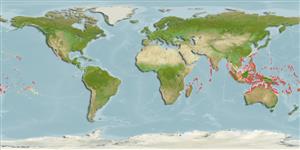Common names from other countries
Environment: milieu / climate zone / depth range / distribution range
Ecologia
marino associati a barriera corallina; distribuzione batimetrica 0 - 30 m (Ref. 128797). Tropical; 30°N - 24°S
Indo-Pacific: East Africa to the Tuamoto Islands, north to the Ryukyu Islands, south to New Caledonia.
Size / Peso / Age
Maturity: Lm ? range ? - ? cm
Max length : 35.0 cm TL maschio/sesso non determinato; (Ref. 5213); common length : 23.0 cm TL maschio/sesso non determinato; (Ref. 9948)
Spine dorsali (totale): 11; Raggi dorsali molli (totale): 12-14; Spine anali 4; Raggi anali molli: 8 - 9. Body iridescent silvery with dark red or black mark on each scale (Ref. 4201). Spinous portion of dorsal fin black; soft dorsal, anal and caudal fins reddish yellow; pectoral fins pink, pelvic fins white (Ref. 4201). Lower jaw strongly projecting
Inhabits subtidal reef flats and lagoon and seaward reefs to depths of at least 20 m. Found singly or in small groups in coral-rich areas (Ref. 9710). Feeds mainly on benthic crabs and shrimps. Large spine at the corner of preopercle is venomous. It raises or flashes its distinctly marked dorsal fin to startle possible predator (Ref. 48635).
Life cycle and mating behavior
Maturità | Riproduzione | Deposizione | Uova | Fecundity | Larve
Myers, R.F., 1991. Micronesian reef fishes. Second Ed. Coral Graphics, Barrigada, Guam. 298 p. (Ref. 1602)
IUCN Red List Status (Ref. 130435)
CITES (Ref. 128078)
Not Evaluated
Human uses
Pesca: scarso interesse commerciale
Informazioni ulteriori
Nomi ComuniSinonimiMetabolismoPredatoriEcotossicologiaRiproduzioneMaturitàDeposizioneFecundityUovaEgg development
BibliografiaAcquacolturaProfilo di acquacolturaVarietàGeneticaElectrophoresesEreditarietàMalattieElaborazioneMass conversion
Strumenti
Special reports
Download XML
Fonti Internet
Estimates based on models
Preferred temperature (Ref.
115969): 25.5 - 29.3, mean 28.5 (based on 2891 cells).
Phylogenetic diversity index (Ref.
82804): PD
50 = 0.5312 [Uniqueness, from 0.5 = low to 2.0 = high].
Bayesian length-weight: a=0.01549 (0.00736 - 0.03261), b=2.97 (2.80 - 3.14), in cm Total Length, based on LWR estimates for this (Sub)family-body shape (Ref.
93245).
Trophic level (Ref.
69278): 3.6 ±0.59 se; based on food items.
Resilienza (Ref.
120179): Alto, tempo minimo di raddoppiamento della popolazione meno di 15 mesi (Preliminary K or Fecundity.).
Fishing Vulnerability (Ref.
59153): Low vulnerability (25 of 100).
